tags: London England, London's Globe Theatre, Shakespeare's Globe Theatre, performing arts, travel
A duel of the drummers at London's Globe Theatre.
The day after Nature's European ScienceBlogging Conference had concluded, I set out to photograph the city with my friend and colleague, Bob O'Hara, and then to attend a play at the Globe Shakespeare Theatre. This photoessay details our Globe Theatre experience.
After roaming around London, taking photographs and drinking beers at a variety of historical pubs, Bob and I walked across London's Millennium Bridge that spans the River Thames.
The Millennium Footbridge spanning the River Thames
as seen from the Tate Modern Art Gallery.
St Paul's Cathedral in the background.
Image: Wikipedia.
The Millennium Footbridge is a modern pedestrian-only steel suspension bridge that links the London neighborhood of Bankside with the rest of the city. Downstream from this bridge is the Southwark Bridge, while upstream is the Blackfriars Bridge. The Millennium Bridge was built in 1998 and is the first new bridge across the Thames since Tower Bridge was completed more than one hundred years ago, in 1894.
Bob and I walked south on this bridge, away from St. Paul's Cathedral, towards our ultimate destination, the Globe Theatre. Also located on the southern end of this bridge is the Bankside Gallery and the Tate Modern Art Gallery, which you can see in the above image.
The Globe Theatre is famous because it was associated with William Shakespeare. This theatre was originally built in 1599 by Shakespeare's company, the Lord Chamberlain's Men, and was later destroyed by a fire in 1613. A second Globe Theatre was rebuilt on the same site by June 1614 but closed in 1642. The current theatre is a reconstruction of the original Globe, and is named "Shakespeare's Globe." This theatre (image below is courtesy of Wikipedia) opened in 1997.
Inside the brick wall surrounding the theatre is an indoor cafeteria and an outdoor mezzanine. While waiting to enter the Globe Theatre, I photographed the stone tiles of the theatre's mezzanine. Most of these tiles, many of which were of different sizes, had names carved into them, and most of the names were of famous people (actors, politicians, artists, writers, etc.). I was amused to see that Michael Palin's name was misspelled as "Pallin". I wonder what he thinks of that?
The stage is a raised platform that is rectangular in shape, and projects out into the central open area known as "the pit". As you can see, there are two very strong support columns holding up the roof that covers the back two-thirds or so of the stage. Beneath this roof is a balcony that the orchestra occupied during the show. The orchestra members liked to lean over the railing to watch the actors' performance, and we often saw them laughing as heartily as the audience.
The stage at London's Globe Theatre, as seen from the "pit"; the standing-only area.
Below is a photo of the seating area for the theatre, as seen from "the pit." You can easily see the lovely paintings on the back walls of these seating areas.
Seeing this show, Shakespeare's comedy, A Midsummer Night's Dream, was all Mike's idea, although I wish I could take credit for it myself. Below is a picture of my friends and colleagues, Bob and Mike, standing with me in "the pit" where all of us "groundlings" stood on hard (very hard!) concrete for the duration of the show.
My friends and colleagues, Bob O'Hara and Mike Dunford, at the Globe Theatre.
The show began when this rather severe-looking gentleman walked out onto the stage and stood with his drum, staring at us. He scolded the audience and told us the house rules: turn off our cell phones and most of all, NO PHOTOGRAPHY ALLOWED after the show commenced. I was extremely disappointed by this second rule, so I resolved to take as many photographs as I could before the play actually started.
A female drummer joined her male counterpart on the stage and it didn't take long before the predictable happened: They had a drumming duel. To say the least, I had a great time photographing this (as you can see from the featured image at the top of this photoessay), and I ended up with a lot of wonderful action images -- so many it was hard to choose which ones to share with you;
The Globe Theatre is circular and is primarily an open air theatre. Around the periphery are the seating areas, which are a series of balconies covered by a roof, as is most of the stage, but the pit where we stood, was open to the elements. It made me wonder what happens when it rains? Do the groundlings just stand there anyway and get wet? And what happpens to the actors when it rains during the parts of the show when they are not under the cover of the roof? Fortunately, it was a bright and warm day, without any trace of storm clouds visible.
Above us were the theatre's audience lights, disguised as a large white globe suspended in mid-air above our heads.
I am especially proud of this photograph (above).
Intermission came at dusk, and it was not a moment too soon, since my feet were killing me by that time. Most of the groundlings took this opportunity to sit on the concrete floor to give their aching feet a rest. I, of course, took this opportunity to take a few more photographs.
This show was nearing the end of its run for the season, so the actors were definitely engaging in some incredibly funny improv. At several points during the show, the actors had the audience laughing so hard that we could barely stand up, but the orchestra and conductor were also laughing so uncontrollably that it looked as though some of them might spill over the balcony railing and fall onto the stage.
Overall, this was a delightful way to spend a beautiful evening in London, especially in the company of several of my friends. It was an experience I doubt I will ever forget. [Read more about the Globe Theatre].
After the show was over, Mike, Bob and I walked across the Millennium bridge to the tube station. Along the way, I photographed this gorgeous cathedral, which I believe is the west end of St. Paul's Cathedral, designed by the amazing Christopher Wren. This image captures only a very poor rendition of what we saw while waiting to cross the street.
- Log in to post comments


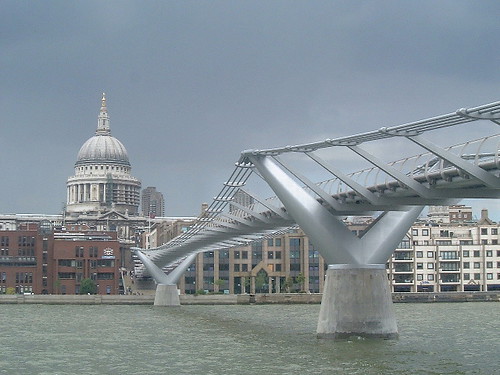
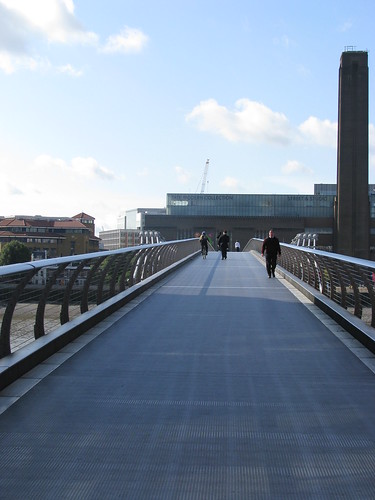
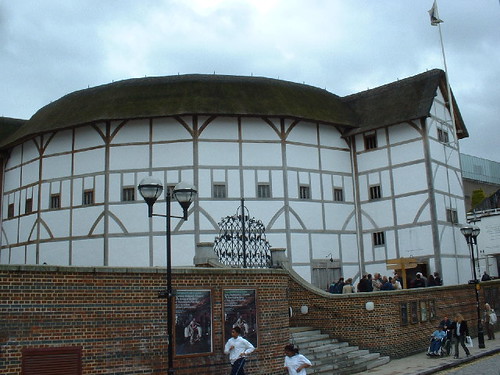
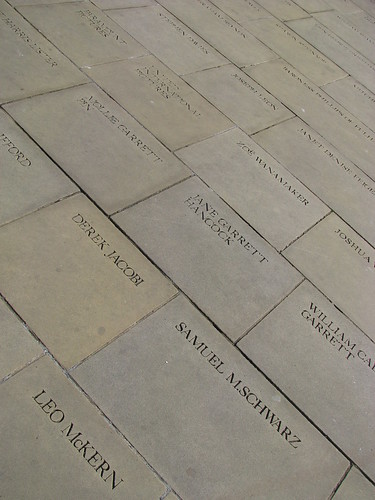
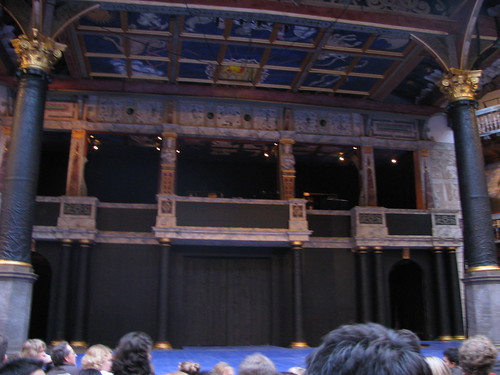
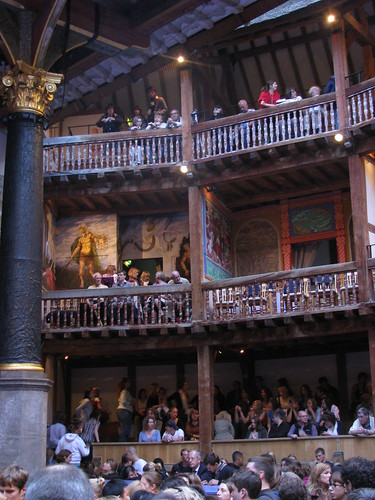


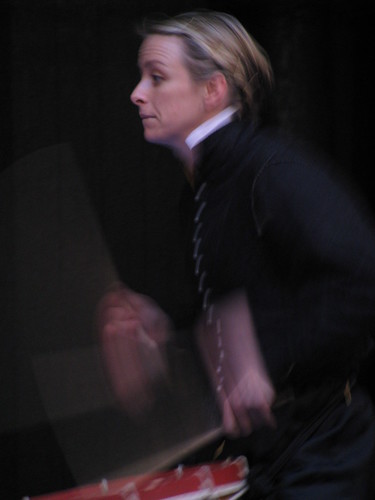


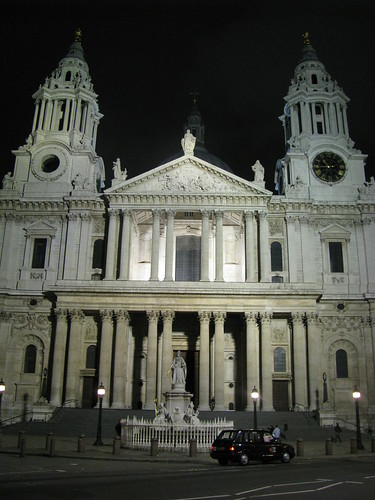
That is St. Pauls. Just round the corner from St Andrew-by-the-Wardrobe.
One small detail - John Clesse's name was spelled correctly, it was Michael Palin's name that was spelled Pallin (I have a photo too!). Someone told me alter that this was all John Cheese's doing.
I notice your photo of the tiles includes the name of Zoë Wanamaker, whose father Sam was largely responsible for the reconstruction of the Globe. If he hadn't been driven out of the US by the House Un-American Activities Committee, it would never have happened - we can be grateful to the HUAC fir that.
Actually, the story goes like this:
You pay about 300 pounds for your flagstone, done as a fundraiser for the building.
Michael Palin brought his.
John Cleese brought one too - and then said he's pay EXTRA to have Palin's name put incorrectly!!
Here's my photo of myself, next to the flagstone, taken this summer. :)
http://tinyurl.com/5rl54f
love the typos, bob.
thanks everyone for telling me the story behind the "pallin" flagstone.